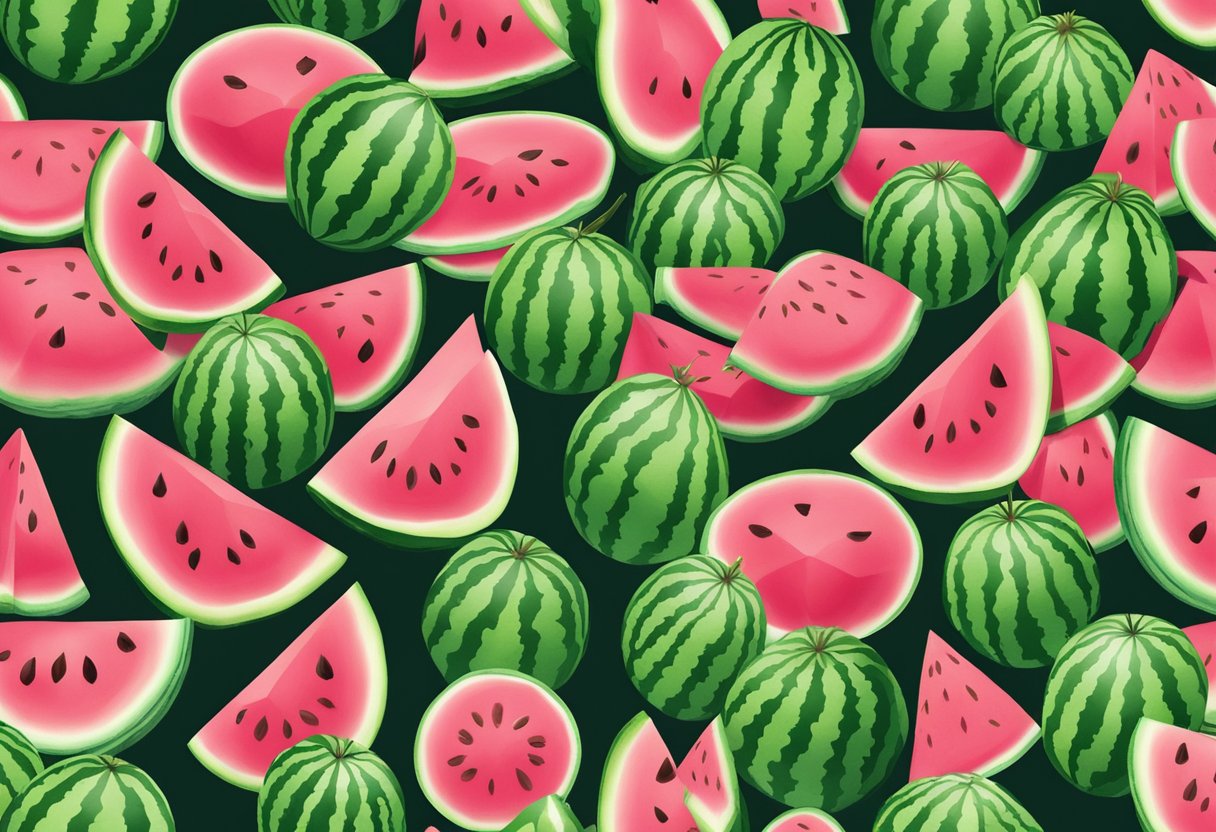Types Of Watermelon
Watermelon is a refreshing summer fruit that is enjoyed by many. It is not only delicious but also packed with nutrients that are beneficial to the body. Watermelon comes in different varieties, each with its unique characteristics, including size, flesh color, and flavor. In this article, we will explore the different types of watermelon, their cultivation, nutritional and culinary uses, as well as how to select and store them.
Varieties of watermelon are classified into four basic types: seedless, picnic, icebox, and yellow/orange fleshed. Seedless watermelons were created in the 1990s and have become increasingly popular due to their convenience. Picnic watermelons are large and can weigh up to 50 pounds, while icebox watermelons are smaller and weigh between 5-15 pounds. Yellow/orange fleshed watermelons are less common and have a sweeter taste than the traditional red-fleshed varieties.
Cultivation and harvest of watermelons require specific conditions, including warm soil, full sun, and regular watering. Watermelons are ready for harvest when the underside turns yellow, and the stem starts to dry out. The fruit should be harvested carefully to avoid bruising and damage. Once harvested, watermelons can be consumed fresh or used in various culinary applications.
Key Takeaways
- Watermelon comes in different varieties with unique characteristics.
- Cultivation and harvest of watermelons require specific conditions.
- Watermelons can be consumed fresh or used in various culinary applications.
Varieties of Watermelon

Watermelons come in a variety of sizes, shapes, and colors. In this section, we will discuss the different types of watermelons, including seedless watermelons, seeded watermelons, mini watermelons, and giant watermelons.
Seedless Watermelons
Seedless watermelons are a popular choice for those who do not want to deal with the hassle of removing seeds. These watermelons are typically smaller in size and have a sweeter taste than seeded watermelons. Some popular varieties of seedless watermelons include Sugar Baby, Crimson Sweet, and Black Diamond.
Seeded Watermelons
Seeded watermelons are the traditional variety of watermelon that most people are familiar with. These watermelons can range in size from small to large and come in a variety of colors, including yellow, orange, and even black. Some popular varieties of seeded watermelons include Charleston Gray, Jubilee, and Moon and Stars.
Mini Watermelons
Mini watermelons, also known as personal-sized watermelons, are a great choice for those who want to enjoy the taste of watermelon without having to buy a large fruit. These watermelons are typically about the size of a cantaloupe and come in both seeded and seedless varieties. Some popular varieties of mini watermelons include Sugar Baby and Tiger Baby.
Giant Watermelons
Giant watermelons are a fun and impressive variety of watermelon that can weigh up to 200 pounds. These watermelons are typically grown for competitions and are not commonly found in grocery stores. Some popular varieties of giant watermelons include Carolina Cross and Black Diamond.
In conclusion, there are many different types of watermelons to choose from, each with its own unique flavor and characteristics. Whether you prefer seeded or seedless, mini or giant, there is a watermelon out there that is perfect for you.
Cultivation and Harvest
Soil and Climate Requirements
Watermelons require warm, nutrient-rich soil with a pH level between slightly acidic to neutral. They prefer warm nights, above 70 degrees Fahrenheit, and at least 80-100 consecutive days of very warm summer temperatures, at least 80 degrees Fahrenheit. Watermelons are a warm-season crop, very tender to frost and light freezes. Therefore, it is recommended to grow them in a greenhouse, garden or backyard where they can receive plenty of sun.
Growing Seasons
Watermelons require a long, warm growing period to produce fruit that is ready to harvest. If started in a greenhouse or indoors, you can get a jump on the season when soil temperatures are above 70 degrees Fahrenheit. The ideal time to plant watermelons is in the early summer. Depending on the variety, it may take around 70-100 days from planting to harvest.
Harvesting Techniques
Harvesting watermelons is a delicate process. Watermelons should be harvested when they are ripe, and the tendrils closest to the fruit are beginning to dry out and turn brown. They should be harvested by cutting the stem with a sharp knife or pruning shears. It is important to avoid damaging the fruit during the harvesting process.
In conclusion, growing watermelons requires warm, nutrient-rich soil and plenty of sun. They can be grown in a greenhouse, garden or backyard. The ideal time to plant watermelons is in the early summer, and depending on the variety, it may take around 70-100 days from planting to harvest. When harvesting watermelons, it is important to be delicate and cut the stem with a sharp knife or pruning shears to avoid damaging the fruit.
Nutritional and Culinary Uses
Health Benefits
Watermelon is a nutrient-dense fruit that is low in calories and high in vitamins and minerals. It is an excellent source of vitamin C, which helps boost the immune system and promotes healthy skin. Watermelon also contains lycopene, a powerful antioxidant that has been linked to a reduced risk of heart disease and certain types of cancer.
In addition, watermelon is rich in citrulline, an amino acid that can help improve blood flow and reduce muscle soreness after exercise. It also contains potassium, which helps regulate blood pressure and maintain a healthy heart.
Culinary Applications
Watermelon is a versatile fruit that can be used in a variety of culinary applications. It is often enjoyed on its own as a refreshing snack or dessert, but it can also be used to add sweetness and juiciness to a variety of dishes.
Watermelon is a popular ingredient in fruit salads, where it adds a burst of color and flavor. It can also be used to make refreshing summer cocktails, such as a watermelon margarita or a watermelon mojito.
In addition, watermelon can be used to make a variety of desserts, such as watermelon sorbet or watermelon granita. It can also be grilled or roasted to bring out its natural sweetness and add a smoky flavor.
Overall, watermelon is a delicious and nutritious fruit that can be enjoyed in a variety of ways. Whether eaten on its own or used in a recipe, it is sure to add a refreshing and flavorful touch to any meal.
Size and Flesh Color Variations
Watermelons come in a variety of sizes and flesh colors, making them a versatile fruit for different occasions and preferences. Here are some of the size and flesh color variations of watermelons:
Size Differences
Watermelons come in different sizes, ranging from small icebox watermelons to large picnic watermelons. Icebox watermelons are small and round, usually weighing between 5 and 15 pounds. They are perfect for small gatherings or for individuals who prefer smaller portions. In contrast, picnic watermelons are large and oval-shaped, usually weighing between 15 and 50 pounds. They are ideal for larger gatherings or for those who prefer more substantial servings.
Flesh Color Diversity
Watermelon flesh can be red, pink, yellow, or orange. Red watermelons are the most common and are usually associated with the classic watermelon flavor we all know and love. Pink watermelons have a sweeter taste and are perfect for those who prefer a milder flavor. Yellow and orange watermelons have a sweeter taste than red and pink watermelons and are perfect for those who prefer a more tropical flavor.
White flesh watermelons are also available, but they are less common than red, pink, yellow, and orange varieties. They have a milder flavor than red watermelons and are perfect for those who prefer a less sweet taste.
It is worth noting that the flesh color of watermelons can vary within the same variety depending on the ripeness of the fruit. For example, a yellow watermelon may have a pale yellow flesh when unripe, but it will turn a deeper shade of yellow as it ripens.
In conclusion, watermelons are available in different sizes and flesh colors, making them a versatile fruit for different occasions and preferences. Whether you prefer a small icebox watermelon or a large picnic watermelon, or a red, pink, yellow, orange, or white flesh watermelon, there is a variety for everyone.
Selecting and Storing Watermelons
Watermelons are a refreshing and delicious fruit that are perfect for hot summer days. There are different types of watermelons available, each with its unique flavor, texture, and appearance. When selecting and storing watermelons, there are a few things to keep in mind to ensure that you get the best quality fruit.
Choosing the Perfect Watermelon
When selecting a watermelon, there are a few things to look for to ensure that it is ripe, sweet, and juicy. The following are some tips to help you choose the perfect watermelon:
- Look for a watermelon with a uniform shape and smooth texture. Avoid watermelons with dents, cracks, or soft spots.
- Check the color of the watermelon. A ripe watermelon should have a deep green color with a dull surface. The underside of the watermelon should have a creamy yellow color.
- Tap the watermelon with your hand. A ripe watermelon should have a hollow sound.
- Check the weight of the watermelon. A ripe watermelon should feel heavy for its size.
Storage and Preservation
Once you have selected the perfect watermelon, it is essential to store it properly to maintain its quality and freshness. The following are some tips for storing and preserving watermelons:
- Store whole watermelons at room temperature until they are cut. Once cut, store the watermelon in the refrigerator.
- Cut watermelon should be stored in an airtight container or wrapped in plastic wrap to prevent it from drying out.
- Watermelons should not be stored in the same area as other fruits and vegetables as they produce high levels of ethylene gas, which can cause other produce to ripen and spoil quickly.
- Watermelons can be frozen for later use. Cut the watermelon into chunks and freeze them on a baking sheet. Once frozen, transfer the chunks to a freezer bag and store them in the freezer.
In cooler climates, it may be challenging to find fresh, ripe watermelons. However, many grocery stores and markets import watermelons from warmer regions, making it possible to enjoy this delicious fruit year-round. With these tips, anyone can select and store the perfect watermelon, ensuring that they get the best quality fruit every time.






